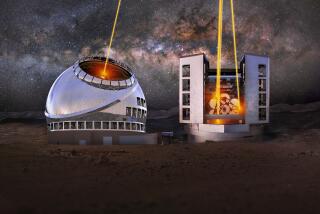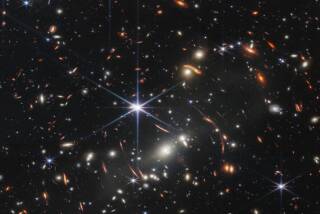Hubble has 3 more years to make amazing discoveries, NASA says
Scientists and space junkies got some good news from NASA on Friday: The space agency announced it would keep the Hubble Space Telescopeâs science operations going at least through April 30, 2016.
The three-year extension will cost NASA $76 million, according to the announcement. The Space Telescope Science Institute in Baltimore manages Hubbleâs science operations for NASA through a contract with the Assn. of Universities for Research in Astronomy.
PHOTOS: Hubbleâs Brilliant Images of Space
Launched in 1990 from the shuttle Discovery, Hubble has contributed to many scientific breakthroughs. My personal favorite is the 1998 discovery that the universe is expanding at an accelerated rate, pushed apart by a mysterious force called dark energy. Cosmologists deduced this by measuring the strength of light from dozens of distant type 1a supernovae and realized that these exploding stars were farther away than had been expected. The scientists behind this discovery (including my college friend Adam Riess) won the 2011 Nobel Prize in Physics.
Other big discoveries include:
A measurement of the Hubble constant. This is a number that takes the speed at which a distant galaxy appears to be receding from us and compares it to its actual distance. If you know this, you can figure out how fast the universe is expanding â and thus, how old it is. In 1999, a team of astronomers used Hubble to figure out that the universe is between 12 billion and 14 billion years old. In 2002, another group narrowed the range to 12 billion to 13 billion years. (This week, researchers using the European Space Agencyâs Planck space telescope came out with a new estimate of 13.8 billion years based on measurements of the cosmic background radiation, a remnant of the Big Bang.)
How galaxies evolve. The telescope has zeroed in on a tiny region of space known as the Hubble Deep Field, which contains galaxies that were born when the universe was still very young. By examining these smaller galaxies â some as old as 10 billion years â scientists have found important differences between their structures and the spiral and elliptical galaxies near the Milky Way, which are younger. The observations have led scientists to theorize that these early galaxies became the building blocks for the ones that came after, perhaps through mergers and other collisions.
Confirming the existence of supermassive black holes. Hubbleâs observations of dozens of galaxies have convinced scientists that such black holes are common in the centers of galaxies, and that their mass is proportional to the mass of the bulge of stars in a galaxyâs middle.
Figuring out how planets are formed. Scientists had believed that planets â including those in our own solar system â formed out of the disk of dust and other material that surrounded young stars. In 1994, Hubble provided visual evidence to support this theory, observing that such disks were common around young stars in the Orion Nebula.
Detecting the atmosphere of an exoplanet. When a Jupiter-like planet passed directly in front of its home star, the light from the star was filtered by the planetâs atmosphere. By analyzing the resulting changes, scientists were able to figure out the composition of the exoplanetâs atmosphere.
Though still going strong after nearly 23 years, Hubble has a replacement on which scientists are working hard. The James Webb Space Telescope will have a mirror thatâs six times bigger, with more than 100 motors to focus it. The new telescope is way over budget and way behind schedule, but NASA officials expect it will launch in 2018.
For a âbriefâ history of how Hubble came to be, check out this write-up from NASA. The story begins way back in 1946.
Return to the Science Now blog.
Follow me on Twitter @LATkarenkaplan
[For the record, 3 p.m. March 27: An earlier version of this post suggested that the Space Telescope Science Institute was responsible for operating the Hubble Space Telescope. NASA keeps the telescope in space and STScI manages its science activities, including selecting research projects, deciding where to point Hubbleâs camera, and collecting and analyzing the resulting data.]







